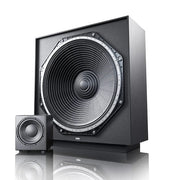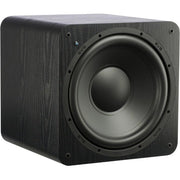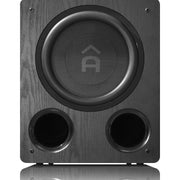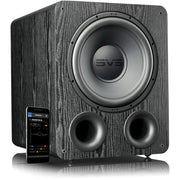Achieving the best possible sound quality in your home theatre setup relies heavily on proper subwoofer placement. Understanding the nuances of subwoofer placement can transform your audio experience, which can in turn enhance your sound experience in your home theatre.
So why does subwoofer placement matter? Read on to discover practical tips for different setups, and expert advice to ensure you unlock superior bass performance.
Does subwoofer placement matter?
Subwoofer placement is crucial because it directly impacts the sound quality and bass performance in your home theatre.
The location of your subwoofer affects how sound waves interact with each other within the room’s acoustics, influencing the clarity, depth, and intensity of bass.
Poor placement can lead to issues such as uneven bass distribution, dead spots, and excessive resonance, which detracts from the overall audio experience.
The science behind subwoofer placement
Sound waves behave differently depending on their frequency. The lower frequencies produced by subwoofers are omnidirectional, meaning they radiate in all directions.
However, room dimensions, furniture, and walls can cause room modes, standing waves, nodes and antinodes, impacting the sound you hear at different positions within the room. Understanding room acoustics and experimenting with subwoofer placement helps minimise these issues and optimise bass performance.

What is a room mode?
In the context of a subwoofer in a home theatre, a room mode refers to the natural resonances that occur within a room due to its dimensions and shape. These resonances cause certain frequencies to be either amplified (resulting in peaks) or diminished (resulting in nulls), significantly impacting the overall bass response in the room.
Formation of room modes
- Sound waves: When a subwoofer produces sound waves, they travel and reflect off the walls, floor, and ceiling.
- Resonance: The dimensions of the room determine the wavelengths that will resonate, leading to standing waves at specific frequencies.
Types of room modes
- Axial modes: These occur between two parallel surfaces (e.g., front to back,side to side, or floor to ceiling). They are the most significant and impactful modes.
- Tangential modes: These involve four surfaces and are less impactful but still affect the sound.
- Oblique modes: These involve all six surfaces and are the least impactful but can still contribute to the overall acoustics.
Impact on bass response
- Peaks: Areas where certain frequencies are amplified, resulting in boomy or overly loud bass.
- Nulls: Areas where certain frequencies are cancelled out, leading to weak or missing bass.
- Uneven distribution: Room modes cause the bass response to vary significantly across different listening positions, making it challenging to achieve a balanced sound.
Factors influencing room modes
- Room dimensions: The length, width, and height of the room determine the frequencies at which room modes occur.
- Subwoofer placement: The position of the subwoofer can excite different room modes, affecting the bass response.
What is a standing wave?
A standing wave in relation to subwoofers in a home theatre is a phenomenon that occurs when sound waves produced by the subwoofer reflect off the walls, floor, and ceiling of the room and interact with each other. This interaction can create areas in the room where certain frequencies are either reinforced (resulting in louder bass) or cancelled out (resulting in quieter bass).
Creation of standing waves
- Sound reflection: Sound waves from the subwoofer bounce off the surfaces in the room.
- Wave interference: These reflected waves interfere with the original sound waves coming directly from the subwoofer.
Effects of standing waves
- Bass reinforcement: In some areas, the sound waves combine in phase, making the bass sound louder.
- Bass cancellation: In other areas, the sound waves combine out of phase, making the bass sound quieter or even non-existent.
Impact on listening experience
- Uneven bass response: Some seats in the room may experience boomy bass while others may have weak bass, leading to an inconsistent listening experience.
- Difficult to correct: These standing waves can be challenging to manage because they are influenced by the room's dimensions and the placement of the subwoofer.
What is a node?
In the context of subwoofers in a home theatre, a node refers to a specific point in the room where the sound pressure level of a particular frequency is at a minimum, often resulting in a noticeable reduction or absence of bass at that location.
Formation of nodes
- Wave Interference: Nodes are formed due to the interference of sound waves reflecting off the walls, floor, and ceiling. When these waves meet and interfere destructively (out of phase), they cancel each other out at certain points.
- Standing waves: Nodes are a result of standing waves, where certain frequencies cause the sound waves to constructively and destructively interfere at fixed points in the room.
Characteristics of nodes
- Low sound pressure: At a node, the sound pressure level is significantly lower than in other parts of the room.
- Frequency specific: Nodes are specific to certain frequencies, meaning they affect some bass notes more than others.
Impact on listening experience
- Uneven bass: Nodes can lead to an uneven bass response in the room, with some seats experiencing much less bass than others.
- Audio imbalance: This can result in an imbalanced audio experience, detracting from the overall enjoyment of movies and music.
What is an antinode?
In the context of a subwoofer in a home theatre, an antinode is a point in the room where the sound pressure level is at its maximum for a given frequency. This occurs due to constructive interference of sound waves, where the waves combine in phase to amplify the sound at that specific point.
Formation of antinodes
- Constructive interference: When sound waves from the subwoofer reflect off the walls, floor, and ceiling, they can meet in phase, meaning the peaks and troughs of the waves align. This alignment amplifies the sound, creating an antinode.
- Standing waves: Antinodes are a result of standing waves in the room, where certain frequencies cause sound waves to constructively interfere at fixed points.
Characteristics of antinodes
- High sound pressure: At an antinode, the sound pressure level is significantly higher, resulting in louder bass.
- Frequency specific: Antinodes occur at specific frequencies where standing waves form. Different frequencies will have antinodes in different locations.
Impact on listening experience
- Boomy bass: Antinodes can cause certain areas in the room to have excessively loud or boomy bass, which can be overwhelming and unbalanced.
- Inconsistent bass response: The presence of antinodes can lead to an uneven bass response throughout the room, with some areas experiencing much louder bass than others.
Guidelines for subwoofer placement (single subwoofer)
- Start with the corner: Placing the subwoofer in the corner of the room can enhance bass response by utilising the walls to amplify low frequencies. This is a good starting point, but it’s essential to test different spots.
- Use the subwoofer crawl: Place the subwoofer in your primary listening position and play a bass-heavy track. Crawl around the room, stopping at various locations where you might place the subwoofer. Mark the spots where the bass sounds the best; these are potential subwoofer placements.
- Avoid placing the subwoofer symmetrically between two walls: This can cause standing waves, resulting in boomy or uneven bass. Instead, try asymmetrical placement to avoid such issues.
Subwoofer placements to avoid
- Placing the subwoofer Inside a cabinet: This can muffle the bass and reduce its effectiveness.
- Ignoring room acoustics: Each room is different; what works in one may not work in another. Always experiment and adjust based on your room’s unique characteristics.
What is the ideal subwoofer placement?
The ideal subwoofer placement depends on the room's size and shape. Placing the subwoofer in a corner or against a wall can significantly affect sound quality.
- Small rooms: In smaller spaces, placing the subwoofer near a wall or in a corner often works well, but be wary of excessive bass amplification.
- Large rooms: Larger rooms may require more experimentation. Try placing the subwoofer a third of the way along the longest wall for balanced bass distribution.
- Irregular shapes: For rooms with unconventional shapes, consider professional acoustic treatment or consultation to determine the best placement.
Corner placement vs wall placement
- Corner placement: This typically boosts bass response but can sometimes lead to boomy bass.
- Wall placement: Placing the subwoofer along a wall can provide smoother, deep bass and reduce the risk of boomy sound. It’s a versatile option that works in many room setups.

What about the placement for multiple subwoofers?
We recommend ideally using two subwoofers or more to significantly enhance the audio experience by providing more even bass distribution and reducing dead spots. This setup can also increase the system’s overall dynamic range, delivering more powerful and immersive sound.
Best practices for 2 subwoofer placement
- Symmetrical placement: Place the subwoofers symmetrically in the room to ensure balanced bass. Common configurations include positioning them in the front corners or along opposite walls.
- Diagonal placement: Placing subwoofers diagonally opposite each other can help minimise room modes and standing waves, leading to smoother bass response.
- Front and back placement: Positioning one subwoofer at the front and the other at the back of the room can enhance the overall coverage and bass uniformity, helping to contribute to a surround sound experience.
In our higher-end systems we usually opt for running four subwoofers in a room, which would generally either be positioned in the corners or at an equal distance in from the side walls on the front and rear wall.
Subwoofer placement with soundbars
To integrate a subwoofer with a soundbar effectively, place the subwoofer near the soundbar to maintain a cohesive soundstage and ensure the bass blends seamlessly with the soundbar's output. Additionally, make sure there are no obstacles between the subwoofer and the listening area to prevent sound waves from being blocked or absorbed.
Positioning to complement the soundbar’s audio output
- Front-firing vs down-firing subwoofers: Choose the type of subwoofer that best suits your room. Front-firing subwoofers are more flexible in placement, while down-firing subwoofers work well on solid, reflective surfaces.
- Adjustable settings: Many subwoofers and soundbars come with adjustable settings. Use these to fine-tune the integration and achieve the best sound balance.

Ideal home cinema subwoofer placement
In dedicated home cinema rooms, the goal is to create an immersive audio experience that exceeds commercial theatres. Proper subwoofer placement is crucial to achieving this.
To maximise bass response, place subwoofers in dedicated corners or along walls and acoustically treat these spots to minimise reflections and resonance. In larger home cinemas, using multiple subwoofers can further enhance low-frequency effects, providing a more cinematic experience.
Tips for achieving the best cinematic experience
- Acoustic panels and bass traps: Use acoustic panels and bass traps to manage room acoustics and reduce unwanted reflections. This ensures the bass is clean and impactful.
- Calibration tools: Use calibration equipment to fine-tune subwoofer placement and settings. This helps achieve the best possible sound quality for your home cinema.
To read more: Umik-1 vs Umik 2: The Ultimate Guide for Perfect Sound Calibration
Step-by-step guide to testing and adjusting subwoofer placement
- Initial placement: Start with the subwoofer in a potential spot, such as a corner or along a wall.
- Play test tones: Use bass-heavy music or test tones to evaluate the sound quality.
- Move and test: Move the subwoofer to different locations, testing the sound quality in each position. This trial and error technique can help you rule out specific placements and narrow down on optimal ones.
- Listen and compare: Sit in your primary listening position and compare the bass quality from each location.
- Finalise placement: Choose the spot that offers the best balance of power and clarity.
Using room calibration tools and software
- Automatic calibration: Many modern AV receivers come with automatic calibration tools that can help optimise subwoofer placement and settings.
- Manual calibration: Use calibration equipment to manually adjust subwoofer settings and placement for the best results. The advanced user may want to consider using REW software with their Umik-1 calibration mic and laptop.

Experience cinematic level bass with CHT Solutions

Ascendo ASC-50SPPS The50 SUB 50" Pro - Passive Infrasonic Sealed Subwoofer

SVS SB1000 Classic Sealed Subwoofer

Ascendo The12 Sub Active Vented Subwoofer 12"

SVS PB-1000 Pro 12" Ported Subwoofer - Black Ash
The best subwoofer placement is essential for unlocking superior bass and achieving the best sound quality in your home theatre. By understanding the principles of subwoofer placement and experimenting with different positions, you can enhance your audio experience and enjoy powerful, clear bass.
Remember to consider room acoustics, and use calibration tools to fine-tune your setup. Whether you’re integrating a subwoofer with a soundbar or setting up a dedicated home cinema, the right placement can make all the difference.
For high-quality audio system equipment, visit our website, or feel free to contact us for obligation-free advice. Our team of audio experts is ready to help you achieve the perfect home theatre sound.







